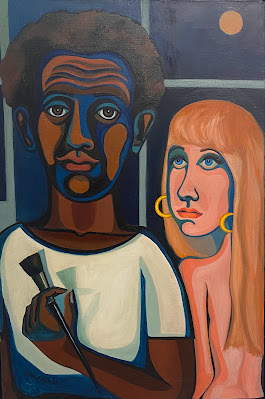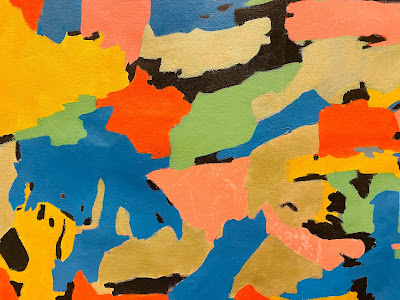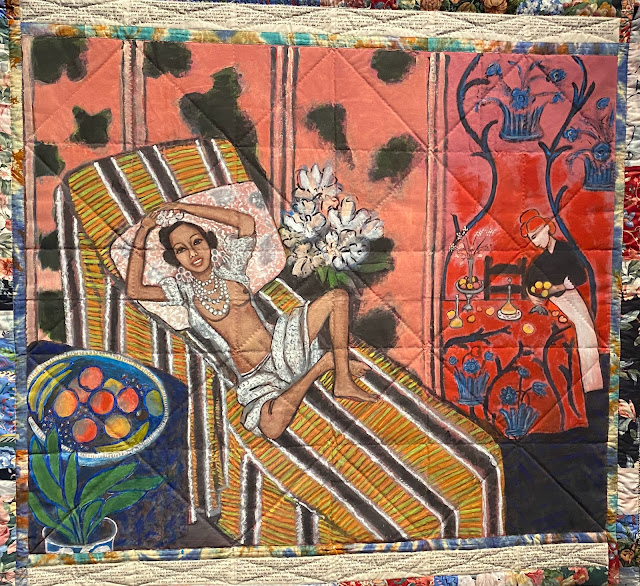Faith Ringgold has been making art for as long as I've been alive but the art establishment only recently has begun giving her due (at 91!) after a career of facing marginalization on three powerful fronts: gender, race and art world snobbery which I'm guessing accounts for how little her work is known. The Museum of Modern Art juxtaposed one of her early paintings with a Picasso and now the New Museum has finally given her a retrospective. Her case is worth more than shedding a few tears.
Her earliest work, painted while teaching art to New York City public school students, reflects a political determination to be seen.
 |
| American People Series #14: Portrait of an American Youth (1964) |
 |
| Black Light Series #1: Big Black (1967) |
You've got to wonder how she feels about the "Me Too" movement given the history of black women in the United States.
 |
| Slave Rape #3: Fight to Save Your Life (1972) |
Her incredible soft sculptures and masks provide a colorful metaphor for code-switching.
 |
| Mrs. Jones and Family, from Family of Woman Mask Series (1973) |
I didn't become aware of her until 2020 when the Met included one of her quilts in its 150th anniversary exhibition. What a brilliant mash-up of artistic medium and ethnic culture.
 |
| "Mother's Quilt" (1980) |
Whether she's working with fabric or paint, Ringgold's color sense is exquisite.
 |
| "Echoes of Harlem" (1980) |
 |
| "The Screaming Woman" (1981) |
 |
| Woman on a Bridge #1 of 5: Tar Beach (1988) |
I was around for the nation's Bicentennial. Trust me, the complexity of our nation's history got lost in all the patriotic hoopla. No slave ships that I can recall floated up the Hudson. And so little has changed since Ringgold began this soft sculpture tableau. The bodies being mourned could be those of Ahmaud Arbery and Breonna Taylor.
 |
| The Wake and Resurrection of the Bicentennial Negro (1975-89) |
Ringgold went to Paris in the early 60s with her mother and daughters. Three decades later she reimagined that art tour with a uniquely African American twist.
 |
| Wedding on the Seine: The French Collection Part I, #2 (1991) |
 |
| The Picnic at Giverny: The French Collection Part I, #3 (1991) |
The artist's model isn't black any longer. Seems like Ringgold really grooved on Matisse given his prominence in several of her French Collection quilts. He was shunned by the art establishment in his time, too.
 |
| Matisse's Model: The French Collection Part I, #5 (1991) |
This gallery shot illustrates the scale of the quilts.
 |
| Dinner at Gertrude Stein's: The French Collection Part 11, #9 (1991) |
Has weight loss ever been given more serious consideration?
 |
| Change 3: Faith Ringgold's Over 100 Pound Weight Loss Performance Story Quilt (1991) |
A late addition to the French Collection, "Jo Baker's Breakfast"depicts a stripper who had to move to France to enjoy her civil rights despite the best efforts of the black male establishment.
 |
| Jo Baker's Birthday: The French Collection Part I, #10 (1993) |
Looks like colors of Morocco enchanted Ringgold as much as they did Yves St. Laurent.
I'm not exactly sure what it is about this painting that I love so much.
 |
| Two Jemimas: The American Collection #9 (1997) |
Even for the casual observer, it would be hard to dispute that Ringold didn't peak until her late 60s.
 |
| We Came to America (detail): The American Collection #1 (1997) |
 |
| The Flag is Bleeding #2: The American Collection #6 (1997) |
 |
| Bessie's Blues: The American Collection #5 (1997) |
 |
| Born in a Cotton Field: The American Collection #3 (1997) |
I would have guessed that she created this work, the latest in the show, much earlier.
 |
| Coming to Jones Road Part 2: Harriet Tubman Tanka #1: Escape to Freedom (2010) |
















No comments:
Post a Comment